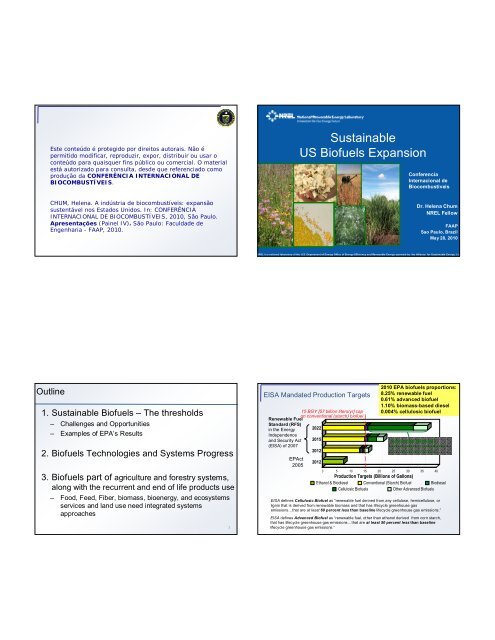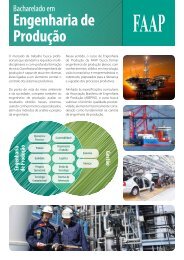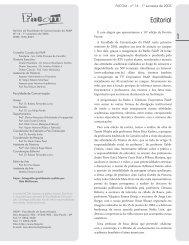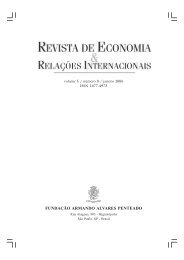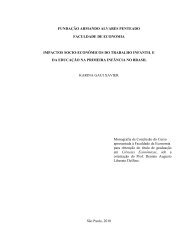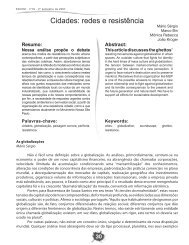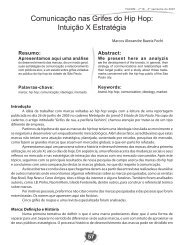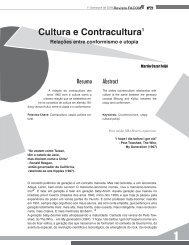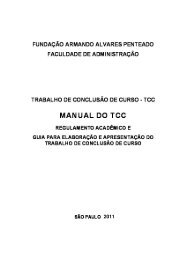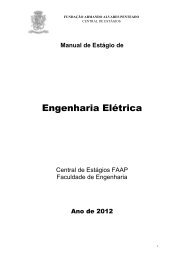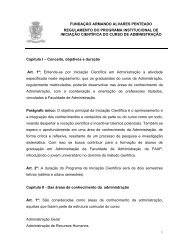Sustainable US Biofuels Expansion - Faap
Sustainable US Biofuels Expansion - Faap
Sustainable US Biofuels Expansion - Faap
Create successful ePaper yourself
Turn your PDF publications into a flip-book with our unique Google optimized e-Paper software.
Este conteúdo é protegido por direitos autorais. Não é<br />
permitido modificar, reproduzir, expor, distribuir ou usar o<br />
conteúdo para quaisquer fins público ou comercial. O material<br />
está autorizado para consulta, desde que referenciado como<br />
produção da CONFERÊNCIA INTERNACIONAL DE<br />
BIOCOMB<strong>US</strong>TÍVEIS.<br />
CHUM, Helena. A indústria de biocombustíveis: expansão<br />
sustentável nos Estados Unidos. In: CONFERÊNCIA<br />
INTERNACIONAL DE BIOCOMB<strong>US</strong>TÍVEIS, 2010, São Paulo.<br />
Apresentações (Painel IV). São Paulo: Faculdade de<br />
Engenharia - FAAP, 2010.<br />
Outline<br />
1. <strong>Sustainable</strong> <strong>Biofuels</strong> – The thresholds<br />
– Challenges and Opportunities<br />
– Examples of EPA’s Results<br />
2. <strong>Biofuels</strong> Technologies and Systems Progress<br />
3. <strong>Biofuels</strong> part of agriculture and forestry systems,<br />
along with the recurrent and end of life products use<br />
– Food, Feed, Fiber, biomass, bioenergy, and ecosystems<br />
services and land use need integrated systems<br />
approaches<br />
3<br />
<strong>Sustainable</strong><br />
<strong>US</strong> <strong>Biofuels</strong> <strong>Expansion</strong><br />
Conferencia<br />
Internacional de<br />
Biocombustiveis<br />
Dr. Helena Chum<br />
NREL Fellow<br />
FAAP<br />
Sao Paulo, Brazil<br />
May 28, 2010<br />
NREL is a national laboratory of the U.S. Department of Energy Office of Energy Efficiency and Renewable Energy operated by the Alliance for <strong>Sustainable</strong> Energy, LLC<br />
EISA Mandated Production Targets<br />
15 BGY [57 billion liters/yr] cap<br />
on conventional (starch) biofuel<br />
Renewable Fuel<br />
Standard (RFS)<br />
in the Energy 2022<br />
Independence<br />
and Security Act 2015<br />
(EISA) of 2007<br />
2012<br />
EPAct<br />
2005<br />
2012<br />
2010 EPA biofuels proportions:<br />
8.25% renewable fuel<br />
0.61% advanced biofuel<br />
1.10% biomass-based diesel<br />
0.004% cellulosic biofuel<br />
Advanced <strong>Biofuels</strong><br />
(include cellulosic biofuels other<br />
than starch-based ethanol)<br />
0 5 10 15 20 25 30 35 40<br />
Production Targets (Billions of Gallons)<br />
Ethanol & Biodiesel Conventional (Starch) Biofuel Biodiesel<br />
Cellulosic <strong>Biofuels</strong> Other Advanced <strong>Biofuels</strong><br />
EISA defines Cellulosic Biofuel as “renewable fuel derived from any cellulose, hemicellulose, or<br />
lignin that is derived from renewable biomass and that has lifecycle greenhouse gas<br />
emissions…that are at least 60 percent less than baseline lifecycle greenhouse gas emissions.”<br />
EISA defines Advanced Biofuel as “renewable fuel, other than ethanol derived from corn starch,<br />
that has lifecycle greenhouse gas emissions…that are at least 50 percent less than baseline<br />
lifecycle greenhouse gas emissions.”
Multiple Simultaneous Advances in Technologies for<br />
Feedstocks --- Conversion --- End Use<br />
Goal: Drive towards an<br />
economic integrated<br />
multistep process<br />
DuPont Danisco<br />
Cellulose Ethanol<br />
<strong>US</strong>DA Data: 5-fold increase since 1940<br />
Can industry reach these yields?<br />
80 new hybrids in 2010
Exploring Routes to Convert Biomass<br />
Feedstock<br />
Production<br />
& Logistics<br />
• Energy<br />
crops<br />
• Forest<br />
Residue<br />
• Agricultural<br />
wastes<br />
• Algae<br />
Integrated Biorefineries<br />
Biochemical Conversion<br />
Pretreatment &<br />
Conditioning<br />
Distillation<br />
Enzymatic<br />
Hydrolysis<br />
Sugars Fermentation<br />
Enzyme<br />
By-Products<br />
Production<br />
Wastes/Residue<br />
Thermochemical Conversion<br />
Upgrading<br />
Fast Liquid Zeolite Cracking<br />
Pyrolysis Bio-oil Hydrogenolysis<br />
Gasification Syngas<br />
Lipid (Oil)<br />
Extraction<br />
Algal<br />
Oil<br />
Fischer Tropsch<br />
Alcohol Synthesis<br />
Transesterification<br />
Upgrading<br />
R E F I N I N G<br />
Research on multiple conversion pathways aims to improve the<br />
efficiency and economics of biofuels production.<br />
DDGS (corn)<br />
Lignin<br />
(for power)<br />
Ethanol<br />
Butanol<br />
Olefins<br />
Gasoline<br />
Diesel<br />
Others<br />
Program Areas & Key Challenges<br />
Feedstock<br />
Systems<br />
– Diverse regional<br />
biomass<br />
resources<br />
– Yield & price<br />
– Water & fertilizer<br />
– Land use<br />
– Metrics &<br />
standards<br />
Sustainability<br />
Research & Development Demonstration & Deployment<br />
Conversion Technologies<br />
Biochemical<br />
– Cost & Efficiency<br />
• Pretreatments<br />
• Enzymes/yields<br />
– Fermentation<br />
Thermochemical<br />
– Cost & Efficiency<br />
– Gasification Process<br />
– Fuel Stabilization<br />
• GHG emissions<br />
• Water quality<br />
• Land use<br />
• Socioeconomics<br />
Integrated<br />
Biorefineries<br />
– Integrating<br />
process<br />
technologies<br />
– Financing<br />
– Technical<br />
expertise<br />
– Profit potential<br />
Product Development<br />
− Fuel purity & cost<br />
− By-products/markets<br />
− Infrastructure compatibility<br />
Major DOE <strong>Biofuels</strong> Project Locations<br />
Pacific Ethanol<br />
(Boardman, OR)<br />
Nov ozymes<br />
(Dav is, CA)<br />
Genencor<br />
(Palo Alto, CA)<br />
Ceres, Inc<br />
(Thousand Oaks, CA)<br />
Verenium Corp (2)<br />
(San Diego, CA)<br />
BlueFire Ethanol<br />
(Mecca, CA)<br />
Eight Small-Scale Biorefinery Projects<br />
Four Commercial-Scale Biorefinery Projects<br />
Four Improved Enzyme Projects<br />
Emery Energy<br />
(Salt Lake City, UT)<br />
Five Projects for Fermentation Organisms<br />
Five Thermochemical Syngas Projects<br />
DOE Joint Solicitation Biomass Projects<br />
Five Thermochemical Bio-Oil Projects<br />
Six University Conversion Projects<br />
Montana State University<br />
(Bozeman, MT)<br />
Lignol<br />
(Grand Junction, CO)<br />
Abengoa<br />
(Hugoton, KS )<br />
Cargill Inc<br />
(Minneapolis, MN)<br />
Flambeau Riv er<br />
(Park Falls, WI)<br />
NewPage<br />
(Wisconsin Rapids, WI)<br />
Poet<br />
(Emmetsburg, IA)<br />
Office of Science Bioenergy<br />
Centers<br />
DOE Great Lakes, Madison, WI<br />
DOE Joint Bioenergy Institute, Berkeley,<br />
CA<br />
DOE Bioenergy Science Center, Oak<br />
Ridge, TN<br />
Univ ersity of Minnesota<br />
(Minneapolis, MN)<br />
Iowa State (3) Univ ersity<br />
(Ames, IA)<br />
UOP, LLC<br />
(De s Plaines, IL)<br />
Infrastructure<br />
– Transport<br />
– Storage<br />
– Codes &<br />
Standards<br />
(Blend wall)<br />
– Demand/<br />
markets<br />
– Compatibility<br />
• Predictive Modeling<br />
• International<br />
Purdue Univ ersity (2)<br />
(West Lafaye tte, IN)<br />
Alltech<br />
Env irofine<br />
(Washington<br />
County, KY)<br />
Southern Research<br />
Institute<br />
(Birmingham, AL)<br />
Mascoma<br />
(Kinross, MI)<br />
Gas Technology Institute<br />
(Des Plaines, IL)<br />
Verenium <strong>Biofuels</strong> Corp.<br />
(Jennings, LA)<br />
Georgia Tech<br />
(Atlanta, GA)<br />
Range Fuels<br />
(Soperton, GA)<br />
Mascoma<br />
(Lebanon, NH)<br />
Univ ersity of Georgia<br />
(Athens, GA)<br />
Univ ersity of Maine<br />
(Orono, ME)<br />
Regional<br />
Partnerships<br />
South Dakota State Univ., Brookings, SD<br />
Cornell University, Ithaca, NY<br />
Univ. of Tennessee, Knoxville, TN<br />
Oklahoma State Univ., Stillwater, OK<br />
Oregon State Univ., Corvallis, OR<br />
RSE Pulp &<br />
Chemical, LLC<br />
(Old Town, ME)<br />
Cornell Univ ersity Univ ersity of Mass<br />
(Ithaca, NY)<br />
(Amherst, MA)<br />
GE Global Research<br />
(Niskayuna, NY)<br />
Stevens Institute of<br />
Technology<br />
(Hoboken NJ)<br />
Univ eristy of<br />
Toledo<br />
(Toldeo, OH)<br />
Virginia Tech<br />
(Blacksburg, VA)<br />
DSM Innovation Center<br />
(Parsippany, NJ)<br />
Dupont<br />
(Wilmington, DE )<br />
Research Triangle Institute (2)<br />
(Research Triangle Park, NC)<br />
Modified 10/1/2008
Key Recent Accomplishments and Deliverables<br />
EPACT Section 932 “Commercial-Scale” Biorefineries<br />
DOE investments in cellulosic biofuels will accelerate commercialization<br />
and help create a biofuels market based on non-food feedstocks.<br />
Performers<br />
Poet<br />
Emmetsburg, IA<br />
Range Fuels<br />
Soperton, GA<br />
Abengoa<br />
Hugoton, KS<br />
Bluefire<br />
Fulton, MS<br />
Feedstock<br />
Type<br />
Corn Cob<br />
Corn Fiber<br />
Woody<br />
Waste<br />
Agricultural<br />
Residue<br />
Conversion<br />
Technology<br />
Fuel Type Status<br />
Biochemical Ethanol Engineering and construction in<br />
progress. Cobs feedstock<br />
infrastructure set up<br />
Gasification + Mixed<br />
Alcohol synthesis<br />
Mixed<br />
alcohols<br />
Engineering and construction in<br />
progress.<br />
Biochemical Ethanol NEPA EIS process initiated. Corn<br />
stover infrastructure set up<br />
Sorted MSW Biochemical-<br />
Concentrated Acid<br />
Hydrolysis<br />
Ethanol Lease and NEPA issues being<br />
resolved.<br />
Key Recent Accomplishments and Deliverables<br />
Demonstration-Scale Biorefineries: FY08 Award One, Under Negotiation<br />
Alltech-Envirofine<br />
Washington County, KY<br />
Lignol Innovations<br />
Grand Junction, CO<br />
Mascoma<br />
Upper Peninsula, MI<br />
NewPage<br />
Wisconsin Rapids, WI<br />
Pacific Ethanol<br />
Boardman, OR<br />
RSA<br />
Old Town, ME<br />
Performers Feedstock Type<br />
Verenium <strong>Biofuels</strong> Corp.<br />
Jennings, LA<br />
Flambeau River <strong>Biofuels</strong> LLC<br />
Park Falls, WI<br />
Corn Cobs, Corn<br />
Fiber<br />
Conversion<br />
Technology<br />
Biochemical-Solid<br />
State Fermentation<br />
Woody Biomass Biochemical-<br />
Organisolve<br />
Ethanol<br />
Ethanol<br />
Woody Biomass Biochemical Ethanol<br />
Woody Biomass<br />
- Mill Residue<br />
Wheat Straw,<br />
Stover, Poplar<br />
Residuals<br />
Woody Biomass<br />
- Mill residues<br />
Energy Cane and<br />
Bagasse<br />
Forest residues<br />
and wood waste<br />
Thermochemical-<br />
Fischer-Tropsch<br />
Biochemical-Biogasol Ethanol<br />
Biochemical-Pentose<br />
Extraction<br />
Biochemical Process Ethanol<br />
Thermochem to<br />
Fischer-Tropsch<br />
Fuel Type<br />
Fischer-Tropsch liquids<br />
To be determined<br />
Fischer-Tropsch liquids<br />
Pilot Plant, Scotland, South Dakota<br />
Key Stakeholder Relationships<br />
Regional Biomass Energy Feedstock Partnership Bioenergy Crop Trials<br />
In 2008, the Biomass Program, Sun Grant Initiative universities, and <strong>US</strong>DA selected, and<br />
in some cases established the first round of replicated field trials of corn stover<br />
removal and dedicated herbaceous energy crops.<br />
This map shows<br />
the selected<br />
locations and<br />
types of crops.
DOE<br />
Office of<br />
Science<br />
Advanced<br />
Feedstock &<br />
Conversion<br />
Technologies
Grand Challenge: Next-Generation Bioenergy Crops Center Strategies<br />
• GLBRC – Engineer “model” plants and potential energy crops to produce new forms of lignin and more<br />
starches and oils, which are more easily processed into fuels.<br />
• JBEI – Enhance lignin degradation in “model” plants by changing cross-links among lignin subunits;<br />
improve deconstruction and subsequent fermentation by altering linkages between lignin and other cellwall<br />
components; translate genetic developments to switchgrass.<br />
• BESC – Decrease or eliminate harsh chemical pretreatments by engineering plant cell walls in poplar<br />
and switchgrass to be less recalcitrant; simultaneously increase total biomass produced per acre.<br />
Grand Challenge: Discovery and Design of Enzymes and Microbes with Novel<br />
Biomass-Degrading Capabilities Center Strategies<br />
• GLBRC – Identify combinations of enzymes and pretreatment needed to digest specific biomass types;<br />
express biomass-degrading enzymes in the stems and leaves of corn and other plants.<br />
• JBEI – Develop new ionic liquid pretreatments that can completely solubilize and fractionate biomass<br />
components; improve performance and stability of enzymes obtained from the rainforest floor and<br />
other environments; engineer, through directed evolution, highly efficient cellulase enzymes.<br />
• BESC – Screen natural thermal springs to identify enzymes and microbes that effectively break down<br />
and convert biomass at high temperatures; understand and engineer cellulosomes (multifunctional<br />
enzyme complexes for degrading cellulose).<br />
Grand Challenge: Development of Transformational Microbe-Mediated Strategies<br />
for Biofuel Production Center Strategies<br />
• GLBRC – Start with an ethanol-producing microbe and add lignocellulose-degrading capabilities to<br />
substantially reduce costs.<br />
• JBEI – Connect diverse biological parts and pathways to create entirely new organisms that produce<br />
fuels other than ethanol; engineer organisms to produce and withstand high concentrations of biofuels;<br />
derive useful chemical products from lignin degradation.<br />
• BESC – Start with a lignocellulose-degrading microbe and add ethanol-producing capabilities to<br />
substantially reduce costs; develop a knowledgebase and pathway analysis tools to aid this manipulation.<br />
Chum, 12/2009 Chum, 12/2009
Chum, 12/2009<br />
NSF. 2008. Breaking the Chemical and Engineering Barriers to Lignocellulosic <strong>Biofuels</strong>: Next Generation Hydrocarbon<br />
Biorefineries. Ed. George W. Huber, University of Massachusetts Amherst. National Science Foundation. Chemical,<br />
Bioengineering, Environmental, and Transport Systems Division. Washington D.C. 180 p.<br />
http://www.ecs.umass.edu/biofuels/Images/Roadmap2-08.pdf<br />
Chum, 12/2009
Chum, 12/2009<br />
Chum, 12/2009<br />
Summary<br />
• Promises<br />
– Increased Understanding from Advances in Science and<br />
Engineering Leading the Possibility of Designed Systems<br />
– Recognized the Need for Integration of Technologies along the<br />
Supply Chain, Systems and Uses – Buying Down Risk<br />
• Challenges<br />
– Technology Development and Learning Curves - timing<br />
– Uncertainties and Risks – Financial, Regulatory, Security…<br />
– Complexity of systems, families of technologies, multiplicity of<br />
choices with no clear winner<br />
• Innovation and Leadership<br />
– Required for the Development of Integrated <strong>Sustainable</strong> Biomass<br />
Systems
37<br />
Update on EPA RFS2<br />
Type of Model Example Explanation<br />
General equilibrium models represent the<br />
whole economy and the main interactions<br />
between economic sectors of a single<br />
region or multiple regions.<br />
Partial equilibrium models give a detailed<br />
description of a specific economic sector.<br />
Optimization models aim to allocate<br />
resources by maximizing or minimizing an<br />
objective function, generally an economic<br />
objective function of profit or utility.<br />
Agent-based models focus on the<br />
simulation of actors’ decisions<br />
System Dynamics models simulate timedependent<br />
phenomena such as land-use<br />
change and account for feedbacks in the<br />
system<br />
GTAP Global Trade Analysis Project model, a multi-region, multi-sector, computable<br />
general equilibrium model that estimates changes in world agricultural<br />
production. Maintained through Purdue University, GTAP projects international<br />
land use change based on the economics of land conversion. Website:<br />
https://www.gtap.agecon.purdue.edu/default.asp<br />
FAPRI Integrated Food and Agricultural Policy and Research Institute with the<br />
international models, as maintained by the Center for Agricultural and Rural<br />
Development (FAPRI-CARD) at Iowa State University. Website:<br />
http://www.fapri.iastate.edu/<br />
FASOM Forestry and Agriculture Optimization Model (FASOM) of Texas A&M University<br />
with a much more detailed economic description of the agriculture and<br />
forestry sector. Website: http://agecon2.tamu.edu/people/faculty/mccarlbruce/FASOM.html<br />
Carnegie- Linking global and local dynamics and modeling indirect land use change from<br />
Stanford <strong>Biofuels</strong> biofuel demand (e.g., simulate sugarcane expansion dynamics in the Brazilian<br />
project<br />
agricultural frontier) .Work presented at Roundtable on <strong>Sustainable</strong> <strong>Biofuels</strong>,<br />
Sao Paulo, November, 2008.<br />
http://cgse.epfl.ch/webdav/site/cgse/shared/<strong>Biofuels</strong>/Regional<br />
%20Outreaches%20&%20Meetings/LUC%20Workshop%20Sao%20Paulo/<br />
Presentations%20day%202/Fernandez.pdf<br />
STELLA-based<br />
SheehanBoyce<br />
The Systems Thinking Experimental Learning Laboratory with<br />
Animation (STELLA) simulate the biofuel production chain in the<br />
U.S. accounting for land in the feedstock-production phase and the<br />
greenhouse-gas emissions from indirect land-use changes.<br />
http://www.bio.org/letters/CARB_LCFS_Sheehan_200904.pdf<br />
Lifecycle Assessment (LCA) GREET Greenhouse Gases, Regulated Emissions, and Energy Use in Transportation<br />
Model, developed by Argonne National Laboratory. Website:<br />
http://www.transportation.anl.gov/modeling_simulation/GREET/
EPA, 2010, Renewable Fuel Standard Program (RFS2)<br />
Regulatory Impact Analysis, EPA-420-R-10-006,<br />
February 2010,<br />
http://www.epa.gov/otaq/renewablefuels/420r10006.pdf<br />
CARB, 2010. January 10, 2010, FINAL REGULATION ORDER,<br />
Subchapter 10. Climate Change, Article 4. Regulations to<br />
Achieve Greenhouse Gas Emission Reductions, Subarticle 7.<br />
Low Carbon Fuel Standard,<br />
http://www.arb.ca.gov/regact/2009/lcfs09/lcfs09.htm<br />
For information on current DOE Biomass<br />
Program Activities see:<br />
http://www.obpreview2009.govtools.us/review/<br />
Support from the DOE Office of the Biomass Program is<br />
greatly acknowledged<br />
Helena.Chum@nrel.gov.<br />
Visit us online at www.nrel.gov .<br />
National Renewable<br />
Energy Laboratory<br />
Operated Innovation for the U.S. for Department Our Energy of Energy Office of Energy Efficiency and Renewable Energy by Midwest Research Institute • Battelle<br />
Future


